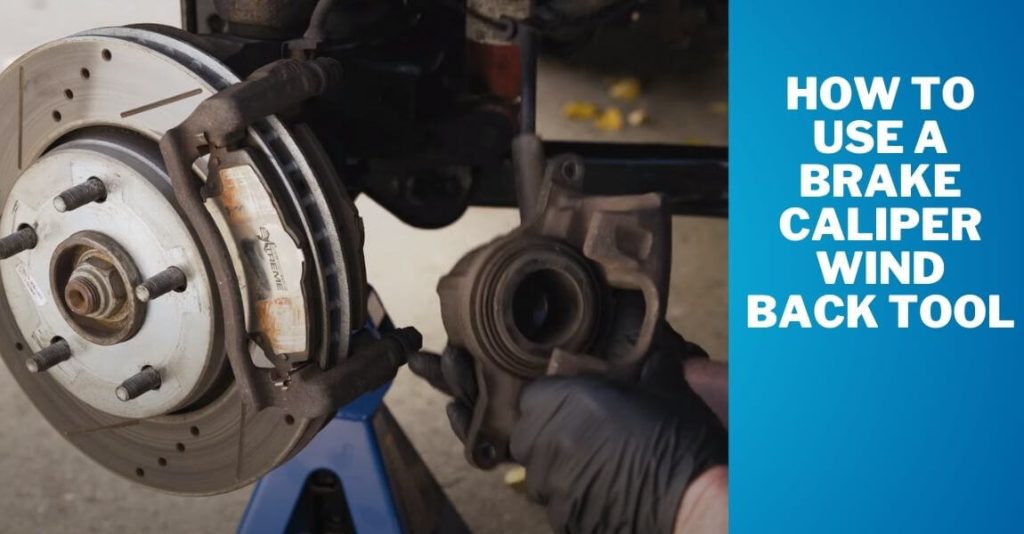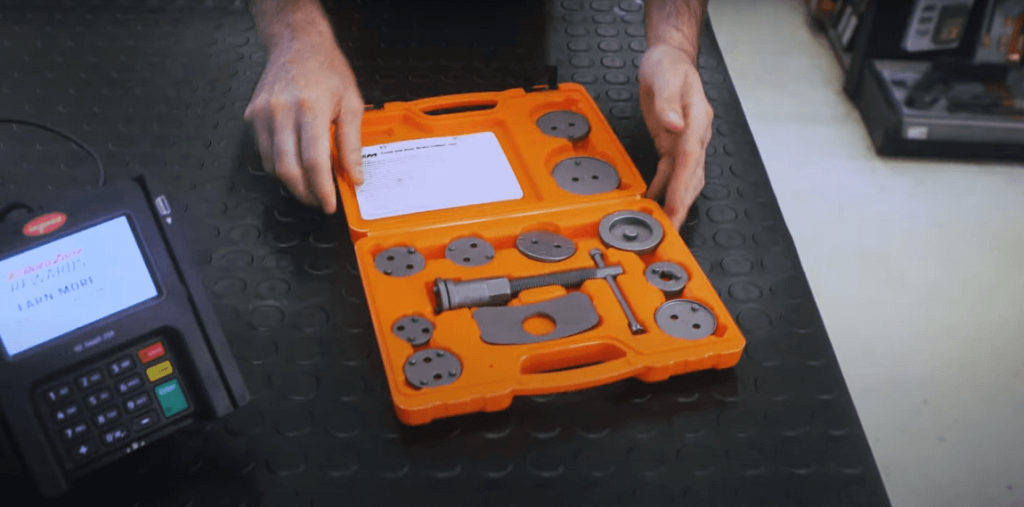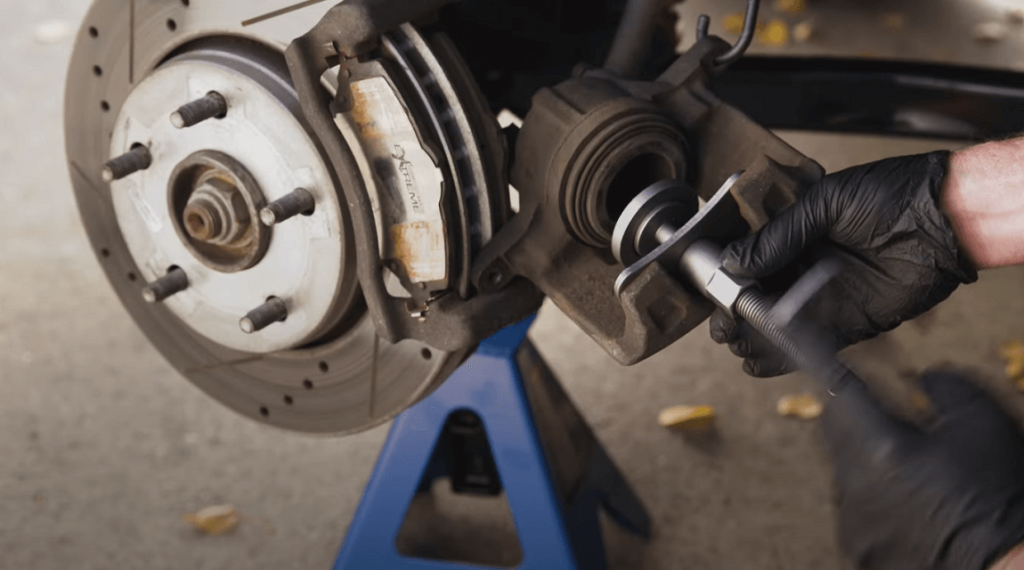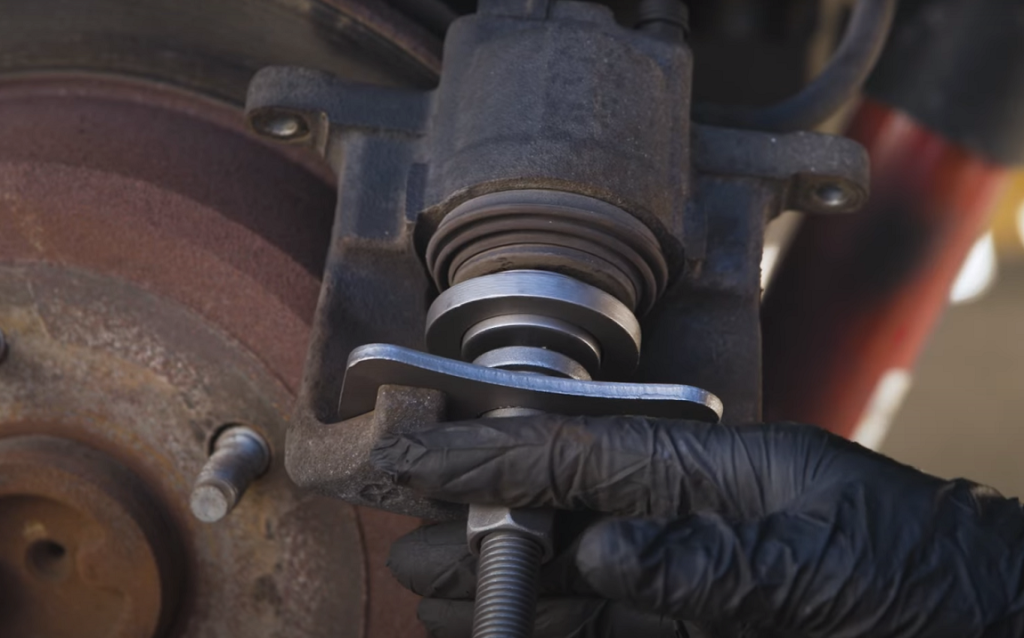This article was updated in September 4, 2023 with new products and information by Mark S. Taylor
To use a brake caliper wind back tool, first, select the right adapter for your caliper, then attach it to the tool. Insert the adapter into the caliper piston and turn the tool clockwise to retract the piston and make room for new brake pads.
Introducing the brake caliper wind back tool, a handy device that simplifies the process of replacing brake pads. If you’re a DIY mechanic or simply want to save money by performing basic brake maintenance yourself, this tool is a must-have.
By following a few simple steps, you can easily retract the caliper piston and make room for new brake pads, ensuring smooth and safe braking. So, let’s delve into the details of how to use a brake caliper wind back tool effectively.

Contents
Understanding The Functionality Of A Brake Caliper Wind Back Tool
If you’re a diy mechanic or simply want to save some money on brake pad replacements, a brake caliper wind back tool is an essential gadget to have in your toolbox. This nifty tool allows for easy retraction of the caliper piston when changing brake pads, making the whole process a breeze.
Here’s a breakdown of how a brake caliper wind back tool works:
Explanation Of How A Brake Caliper Wind Back Tool Works:
- The brake caliper wind back tool is specifically designed to fit into the slots or notches on the caliper piston.
- Once securely in place, the tool applies equal pressure on both sides of the piston.
- By rotating the tool in a clockwise motion, the piston is gradually pushed back into the caliper housing.
- This action compresses the piston, creating enough space for the new, thicker brake pads to be easily fitted.
A brake caliper wind back tool simplifies the task of retracting the caliper piston, ensuring a smoother brake pad replacement process. Say goodbye to frustrating and time-consuming manual methods, and say hello to the convenience of a brake caliper wind back tool.
Choosing The Right Brake Caliper Wind Back Tool
When it comes to performing brake maintenance or replacing brake pads, having the right tools is essential. One such tool that every DIY enthusiast or professional mechanic should have is a brake caliper wind back tool. This tool makes the process of retracting the caliper piston much easier and prevents damage to the caliper or brake components.
But with so many options available in the market, how do you choose the right brake caliper wind back tool? Here are some factors to consider when selecting a brake caliper wind back tool:
Factors To Consider When Selecting A Brake Caliper Wind Back Tool:
- Compatibility: Each vehicle model and make may require a different type of brake caliper wind back tool. It is important to choose a tool that is compatible with your specific vehicle to ensure proper functionality.
- Ease of use: Look for a tool that is easy to operate and does not require excessive force or complex setups. This will save you time and effort during the brake maintenance process.
- Ergonomics: Long hours of working with the tool can strain your hands and arms. Opt for a brake caliper wind back tool that offers comfortable grips and ergonomic design, allowing for seamless operation.
- Versatility: Some brake caliper wind back tools are designed to work with multiple vehicle models and brake systems. Investing in a versatile tool not only saves you money but also ensures that you can use it for various brake maintenance tasks.
- Durability: Brake maintenance is a regular task, so you want a tool that can withstand frequent use without wearing out or breaking. Look for a brake caliper wind back tool made from high-quality materials that are built to last.
- Visibility: Some brake caliper wind back tools come with additional features such as built-in pressure indicators or extra-long handles for better visibility and control during the retracting process. Consider these additional features based on your requirements.
With these factors in mind, you can now make an informed decision when selecting the right brake caliper wind back tool for your needs. Remember, choosing a reliable and suitable tool ensures the safety and efficiency of your brake maintenance tasks.
Step-By-Step Guide On How To Use A Brake Caliper Wind Back Tool

Preparations Before Using The Tool:
Before using a brake caliper wind back tool, it’s essential to make a few preparations to ensure a smooth and safe process. Here are the steps to follow:
- Ensure the vehicle is safely lifted and secured:
- Use sturdy jack stands to lift the vehicle off the ground.
- Locate the manufacturer’s recommended lifting points on the vehicle’s frame.
- Double-check the stability of the vehicle before proceeding.
- Remove the wheel and access the brake caliper:
- Loosen the lug nuts with a lug wrench before raising the vehicle.
- Once lifted, remove the lug nuts and the wheel to access the brake caliper.
- Locate the brake caliper, which is typically positioned above the rotor.
Steps On How To Use The Tool Properly:
Using a brake caliper wind back tool requires proper technique to avoid any damage. Follow these steps for effective usage:
Insert the tool into the caliper piston:
- Choose the appropriate adapter for your specific brake caliper.
- Attach the adapter to the wind back tool securely.
- Align the tool’s pins with the holes or notches on the caliper piston.
- Slowly push the tool into the piston until it fits snugly.
Apply pressure and rotate the tool to retract the piston:
- With the tool fully inserted, begin applying pressure toward the caliper.
- Rotate the tool clockwise while maintaining pressure.
- Continue rotating until the piston starts retracting into the caliper.
Ensure proper alignment and engagement of the tool:
- Throughout the process, keep an eye on the tool’s alignment with the piston.
- Ensure that the pins stay engaged with the holes or notches.
- Avoid tilting or applying excessive force that could cause the tool to disengage.
- Rotate the tool until the piston is fully retracted into the caliper.
Tips And Tricks For Using The Tool Effectively:
To optimize your use of the brake caliper wind back tool, consider the following tips and tricks:
- Refer to the vehicle’s manual or manufacturer’s instructions for specific guidelines.
- Clean the caliper and piston thoroughly before using the wind back tool.
- Lubricate the tool’s pins to prevent friction and ensure smooth operation.
- If the pins continuously slip out of the holes or notches, try alternative adapters.
- Double-check that the piston is fully retracted before installing new brake pads.
- Take your time and work with caution to avoid damaging any components.
- Always wear appropriate safety gear, such as gloves and eye protection, during the process.
By following these step-by-step instructions and implementing the mentioned tips, you can confidently use a brake caliper wind back tool to assist with your brake maintenance and replacement tasks.

Common Mistakes To Avoid When Using A Brake Caliper Wind Back Tool
Brake caliper wind back tools are essential for proper maintenance and repairs of brake calipers. These tools help to retract the caliper piston, making it easier to install new brake pads or rotors. However, if not used correctly, they can lead to unnecessary complications or even damage.
To ensure a smooth and effective brake caliper wind back process, it’s important to avoid these common mistakes:
Over-Tightening Or Under-Tightening The Tool:
- Applying excessive force or torque can damage the caliper piston or the tool itself.
- Insufficient force may result in the caliper piston not fully retracting, causing difficulties during brake pad replacement.
Using The Wrong Tool For The Specific Brake Caliper:
- Each brake caliper design may require a specific type of wind back tool.
- Using an incorrect tool can lead to inefficient retraction or inability to properly engage with the caliper piston.
Not Properly Aligning The Tool With The Caliper Piston:
- Misalignment can prevent the tool from engaging with the caliper piston properly.
- Verify that the tool is secured against the piston’s surface and properly inserted before attempting to wind it back.
By avoiding these common mistakes, you can ensure a successful brake caliper wind back process, saving time and preventing unnecessary complications. Remember to exert the right amount of force, use the correct tool for the caliper model, and align the tool properly with the caliper piston.
Safety Precautions And Additional Considerations:
When using a brake caliper wind back tool, it is important to prioritize safety precautions and consider additional factors to ensure a smooth and trouble-free process. Below are some key considerations to keep in mind:
Importance Of Wearing Safety Gloves And Goggles:
- Always wear safety gloves and goggles when working with a brake caliper wind back tool to protect yourself from potential injuries.
- Safety gloves provide a barrier between your skin and any sharp or hot surfaces, reducing the risk of cuts or burns.
- Goggles safeguard your eyes from debris or particles that may be released during the brake caliper winding process.
Understanding The Specific Requirements Of Your Vehicle’s Brake System:
- Consult your vehicle’s manual or consult a professional to understand the specific requirements and procedures for your vehicle’s brake system.
- Different vehicle models may have unique brake designs, so familiarize yourself with the correct use of the brake caliper wind back tool for your vehicle.
Regular Maintenance And Cleaning Of The Tool:
- It is essential to regularly maintain and clean your brake caliper wind back tool to ensure its optimal performance and longevity.
- Remove any dirt, debris, or brake dust that may accumulate on the tool after each use.
- Lubricate the moving parts to prevent rust and promote smooth operation.
- Store the tool in a clean and dry area to prevent any damage or corrosion.
Remember, taking the necessary safety precautions and understanding your vehicle’s brake system requirements will contribute to a safer and more efficient brake caliper winding process. Regular maintenance of the tool will prolong its lifespan and ensure consistent performance. Stay safe and enjoy hassle-free brake caliper adjustments!

Troubleshooting Tips For Common Issues With A Brake Caliper Wind Back Tool
Properly maintaining your vehicle’s brake calipers is crucial for ensuring optimal braking performance and safety. A brake caliper wind back tool is a handy device that assists in retracting the caliper piston when replacing brake pads or servicing the brakes.
However, like any tool, it’s possible to encounter some common issues. In this section, we will discuss troubleshooting tips for common problems that may arise while using a brake caliper wind back tool.
What To Do If The Tool Gets Stuck Or Jammed:
If you encounter any difficulty with the tool getting stuck or jammed, follow these troubleshooting tips:
- Apply a penetrating oil or lubricant to the tool’s moving parts to alleviate any friction or stiffness.
- Check for any debris or dirt that may be obstructing the tool’s movement. Clean the tool thoroughly before using it again.
- Ensure that you are using the correct size adapter or attachment for your specific brake caliper. Using an improper size can lead to the tool getting stuck.
- If the tool remains jammed or does not work despite troubleshooting, consult the manufacturer’s instructions or contact customer support for further assistance.
How To Troubleshoot If The Tool Doesn’T Fit Properly:
If you encounter issues with the tool not fitting properly, consider the following troubleshooting tips:
- Check that you have the correct adapter or attachment for your vehicle’s brake caliper. Different vehicles may require different sizes or types of adapters.
- Verify that you are using the tool in the correct orientation. Some windback tools have specific instructions for which side of the caliper to apply the tool.
- Inspect the brake caliper for any obstructions, such as dirt or rust, that may prevent the tool from fitting correctly. Clean the caliper if necessary.
- If the tool still doesn’t fit, you may need to consult the vehicle manufacturer’s specifications or seek professional assistance for the correct tool or alternative methods.
Recommendations For Resolving Other Common Problems:
Here are some additional common problems you may encounter when using a brake caliper wind back tool and possible solutions:
- Insufficient pressure: Ensure that you are applying enough force to the tool. You may need to use a breaker bar or additional leverage to retract the caliper piston successfully.
- Damaged or worn tool components: Regularly inspect your wind back tool for any signs of wear or damage. Replace any worn or broken parts to maintain the tool’s effectiveness.
- Incorrect usage: Refer to the manufacturer’s instructions or seek guidance from a professional mechanic to ensure you are using the tool correctly.
- Compatibility issues: Not all brake caliper wind back tools are designed to work with every vehicle. Where possible, confirm the tool’s compatibility with your specific make and model before use.
By following these troubleshooting tips, you can overcome common issues that may arise when using a brake caliper wind back tool. Remember, proper maintenance and care of your tools contribute to efficient and hassle-free brake caliper servicing.
Frequently Asked Questions Of How To Use A Brake Caliper Wind Back Tool
What Is A Brake Caliper Wind Back Tool And How Does It Work?
A brake caliper wind back tool is a tool used to retract the piston in the brake caliper to make room for the new brake pads. It works by fitting onto the caliper piston and rotating it clockwise, applying pressure to retract the piston back into the caliper.
Why Do I Need A Brake Caliper Wind Back Tool?
You need a brake caliper wind back tool to safely and effectively replace your brake pads. This tool allows you to retract the caliper piston, preventing damage to the brake caliper and ensuring proper installation of the new pads.
Can I Use Other Tools Instead Of A Brake Caliper Wind Back Tool?
While it may be possible to use other tools like pliers or a c-clamp to retract the caliper piston, a brake caliper wind back tool is specifically designed for this task. Using the correct tool ensures proper retraction and minimizes the risk of damaging the caliper or brake system.
How Do I Choose The Right Brake Caliper Wind Back Tool?
To choose the right brake caliper wind back tool, consider the type of caliper you have (screw-in or push-back), the size of the piston, and the make and model of your vehicle. Look for a tool that is compatible with your specific needs to ensure proper fit and functionality.
Can I Use A Brake Caliper Wind Back Tool For Other Purposes?
While the primary purpose of a brake caliper wind back tool is to retract the caliper piston during brake pad replacement, it may have other uses depending on its design. However, it is recommended to use the tool as intended to avoid any damage to your vehicle’s braking system.
Conclusion
Overall, a brake caliper wind back tool is an essential tool for anyone working on brake systems. It allows for smooth and efficient caliper retraction, avoiding damage to the caliper and brake pads. By following the simple steps outlined in this blog post, you can easily use a brake caliper wind back tool to successfully retract the caliper piston and replace brake pads or perform other brake maintenance tasks.
Remember to always consult your vehicle’s manual for specific instructions and safety precautions. Investing in a high-quality brake caliper wind back tool is a wise decision that will save you time and money in the long run. So don’t hesitate to add this versatile tool to your toolbox and confidently tackle your next brake maintenance project.
